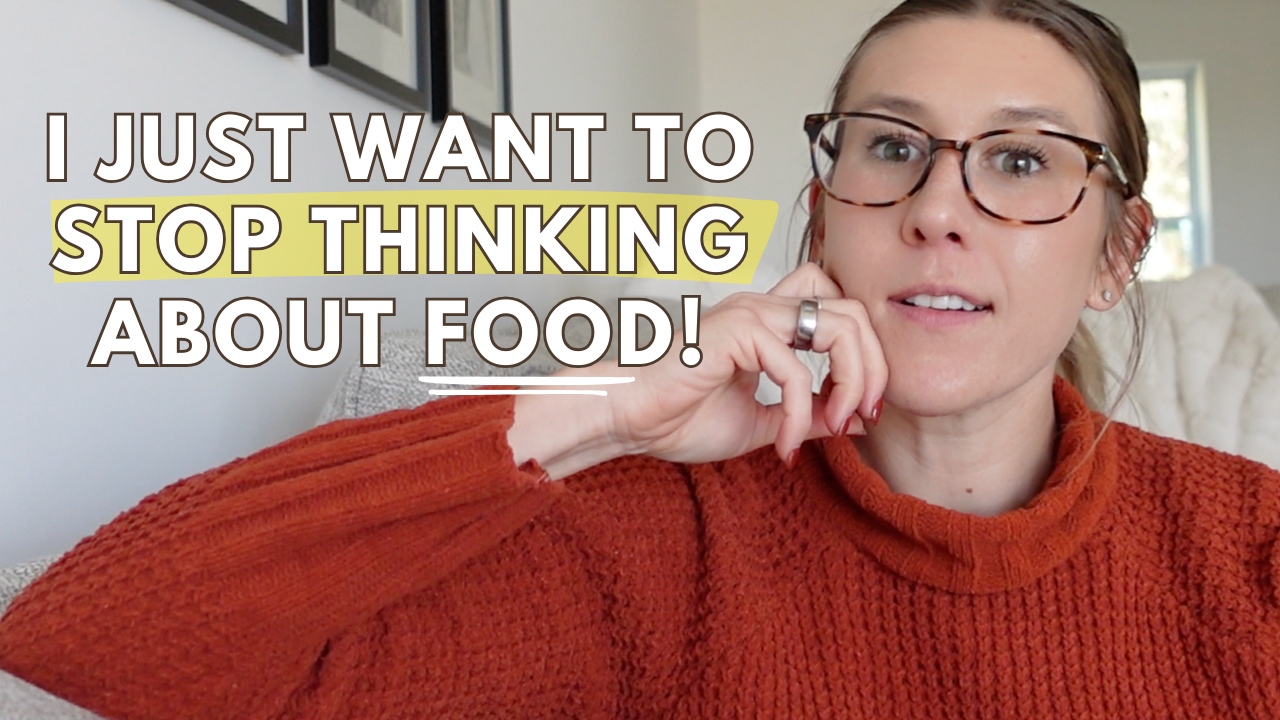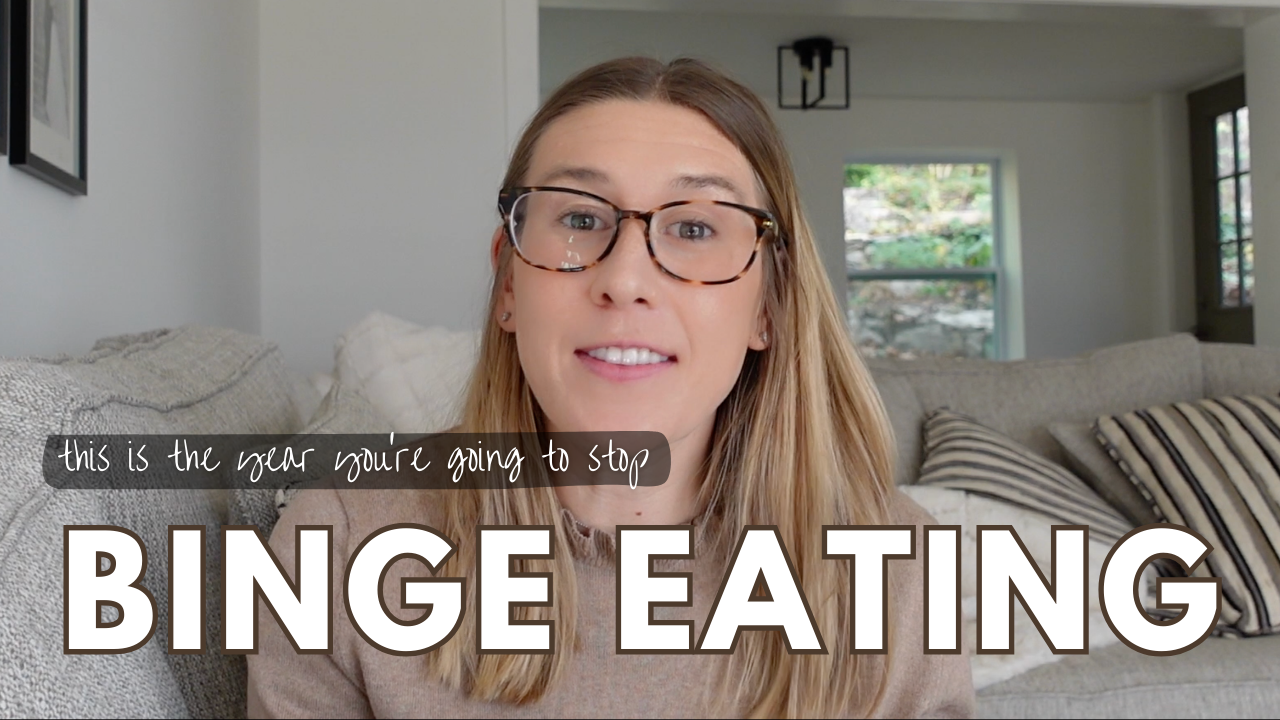Understanding Emotional Eating: Insights from a Therapist
March 6, 2023

Hey There, I'm Ryann Nicole.
I’m a recovered binge eater who changed the story from something that happened to me to something that happened for me. Now, I’m a licensed therapist teaching you to do the same.
My mission? To help you ditch food stress and live your life with mental peace and freedom every single day!
Life is filled with ups and downs, and during the inevitable tough times, many of us turn to food for comfort. There’s nothing wrong with enjoying your favorite meal or treat as a way to lift your spirits or soothe your soul occasionally. Food can indeed provide solace, and sharing a meal with loved ones often brings warmth and connection to our lives.
But what happens when food becomes the primary and, in some cases, the sole means through which you cope with your emotions? You might start to wonder if you’re emotionally eating because you’re genuinely upset, or if it’s because you lack alternative ways to navigate your feelings effectively.
Emotional eating, at its core, is not about demonizing our connection with food but understanding the underlying emotions and the reasons why we turn to it. It’s about recognizing whether you’re reaching for that cookie because it genuinely makes you feel better, or if it’s a response to a deeper, unaddressed issue. Let’s discover how you can establish a healthier and more balanced relationship with food and emotions.
What is Emotional Eating?
Emotional eating is something many of us do when we feel a jumble of emotions. It’s like using food as a friend to make us feel better when we’re upset, stressed, or lonely. It’s like having a chocolate bar or some other comfort food to make us forget about our problems, even if it’s just for a little while. It’s like a quick fix, a way to escape from the mess of feelings we’re going through.
Emotional eating becomes a problem when we keep doing it, again and again, every time we feel bad. It’s like we’re using food as our only solution, without really dealing with the things that are making us upset or stressed. While emotional eating can give us temporary relief, it doesn’t really help us figure out why we’re feeling this way in the first place.
Think of your emotions like the colors in a beautiful painting. They make life interesting and meaningful. Now, imagine trying to paint that picture without any colors; it wouldn’t be the same, right? Emotions are part of life, and they help us understand ourselves better. If you always turn to food to deal with emotions, you miss out on learning how to handle them in a healthier way.
So, managing emotional eating is not about saying no to food or trying to get rid of your feelings. It’s about realizing that your feelings and your food are connected. You can listen to your feelings, like they’re messages from your heart, telling you something important. By doing that, you can find better ways to deal with your emotions, learn and grow. It’s about making friends with your feelings and making good choices about your food, too.
Step One: Identify the Feeling
Before you go for that snack, stop for a moment and think about what you’re feeling. Try asking yourself these questions:
- What made me feel this way? Think about what happened that made you feel like reaching for food. Was it something that someone said or did? Or maybe it was something that happened at work or at home?
- How does this feeling make my body feel? Pay attention to how your body feels when you’re having this emotion. Does your heart beat faster, or do you feel tense or heavy? These physical signs can help you understand your feelings better.
- What thoughts are swirling in my head? Take a moment to notice the thoughts in your mind. Are you thinking about what’s bothering you or something else entirely? Your thoughts can reveal what’s going on inside.
Understanding your feelings is like solving a puzzle. By asking yourself these questions, you can begin to piece together why you’re reaching for that snack in the first place.
Step Two: Welcome the Feeling
Once you know what feeling you’re dealing with, it’s like saying hello to that emotion and understanding why it’s there. You can use this simple way to start:
“Hi, [put the emotion here]. I think you are trying to tell me ____.”
For example:
“Hi, stress. I think you are trying to tell me I need to re-prioritize.”
“Hello, anxiety. I think you are trying to tell me I need to focus on what I can control.”
“Hi, guilt. I think you are trying to tell me I need to remind myself I did nothing wrong.”
“Hello, shame. I think you are trying to tell me I need to find a safe space.”
It’s like having a friendly chat with your emotion and understanding why it’s there. This can help you figure out what your feeling is really about and what you might need to do to make it better.
Step Three: Think About Alternative Ways to Meet That Need
Now that you know what your feelings are telling you, it’s time to discover healthier ways to make yourself feel better. You can use this simple plan:
“Hi, [put the emotion here]. I think you are trying to tell me ____, and I will do that by ____.”
For example:
“Hi, stress. I think you are trying to tell me I need to re-prioritize. I will do that by saying no to things I don’t need to do.”
“Hey, anxiety. I think you are trying to tell me I need to focus on what I can control. I will do that by listing everything I have control over right now.”
“Hi, guilt. I think you are trying to tell me I need to remind myself I did nothing wrong. I will do that by talking to myself.”
“Hello, shame. I think you are trying to tell me I need to find a safe space. I will do that by going and giving my puppy a big snuggle.”
It’s like finding a different way to make yourself feel better without needing to munch on food. By understanding your feelings and figuring out how to meet their needs in a healthier way, you can make your heart and mind happier. It’s a bit like giving yourself a friendly pat on the back and finding what truly makes you feel good inside.
Remember: No Need to Feel Bad
It’s important to know that feeling bad about eating when you’re emotional won’t make things better. Instead, you can use the first three steps we talked about to deal with your feelings. For example:
Instead of telling yourself, “I must stop eating when I’m stressed,” you can ask, “What is this stress trying to tell me I need?”
Instead of wondering, “Why do I always eat when I’m bored?” you can think, “Why do I struggle to find fun things to do when I have free time? What’s really going on?”
Sometimes, when you’re upset and food makes you feel better for a moment, it might seem like it’s fixing everything. But the truth is, it’s just a quick solution. The emotions that made you eat are still there, and you might even feel worse because you’re now carrying the weight of guilt too.
So, instead of being hard on yourself, remember that your feelings are there for a reason. They’re like little messengers, trying to tell you something. By understanding them and making better choices, you can find a more lasting kind of happiness. It’s like letting go of the heavy stuff and making room for the good stuff in your heart.
Emotional eating isn’t about shaming yourself; it’s about learning to confront the discomfort of your feelings and finding a more fulfilling life beyond what food can provide. So, the next time you’re tempted to raid the fridge, use this method to identify your emotions, understand what they’re telling you, and discover a healthier way to meet those emotional needs.
Struggling with hunger and fullness? Check these out:
- 079. What the heck does honoring hunger and feeling fullness even mean? (Episode 1 of 3 with Lisa Schrader, RD)
- 10 Signs of Hunger That Aren’t Stomach Growling
- Hunger and Fullness Masterclass
10 Things To Add To Your Coping Box
Just so you know, I do review everything I recommend. When you buy through links on this page, we may earn a commission.
An emotional coping box, also known as a self-soothe or comfort box, is a personalized collection of items that can help individuals cope with difficult emotions, stress, or challenging situations. It’s a tangible and accessible resource that provides comfort and distraction during moments of distress. Here are 10 things you can consider adding to your emotional coping box:
Include items that bring you comfort, such as a soft blanket, stuffed animal, or cozy socks. These tactile objects can provide a sense of security and grounding.
Write down or print out affirmations and positive quotes that resonate with you. Reading these affirmations can help shift your mindset and promote self-compassion.
Incorporate items that engage your senses, such as scented candles, essential oils, or stress-relief lotion. Pleasant scents can have a calming effect.
Include small items like stress balls, fidget spinners, or textured toys. These can serve as a physical outlet for nervous energy and help redirect focus.
Keep a journal or notebook to write down your thoughts, feelings, and reflections. Journaling can be a therapeutic way to express and process emotions.
Include pictures of loved ones, happy memories, or items that hold sentimental value. Visual reminders of positive experiences can bring comfort and perspective.
Guided Relaxation or Meditation Resources
Include a small audio player or device with pre-loaded guided relaxation or meditation sessions. These can help you practice mindfulness and manage stress.
Playlist of Uplifting Music
Create a playlist of music that brings you joy or relaxation. Music has the power to influence mood, and having a go-to playlist can be a quick mood booster.
List of Coping Strategies
Write down a list of healthy coping strategies that work for you. This could include deep breathing exercises, progressive muscle relaxation, or simple activities that bring you a sense of peace.
Remember, the contents of your emotional coping box should be tailored to your preferences and needs. Regularly review and update the items to ensure they remain effective for you over time. The goal is to have a readily available toolkit that supports your emotional well-being during challenging moments.
check out the pod
Ways I Can Support You
01 Coaching
Intimate group coaching to break free from binge eating
02 podcast
Real talk on food, mindset shifts, motherhood, and finding peace.
03 support group
A safe space to connect with others on the same journey.
04 free coaching
Have real conversations and hear others share their struggles.
Ryann Nicole
Licensed Therapist, Certified Nutritionist, and Virtual Wellness Coach
Ryann is a licensed therapist and virtual wellness coach who has assisted individuals worldwide in establishing a healthier relationship with food and their bodies.
Are You Ready to Heal Your Relationship With Food?
I understand—it can be overwhelming to figure out where to begin. Let's simplify things and have you start right here:
Why Am I Overeating?
First Steps To Stop Binge Eating
The Ryann Nicole
Podcast
FREE QUIZ
FREE GUIDE
Podcast
the food freedom lab podcast




